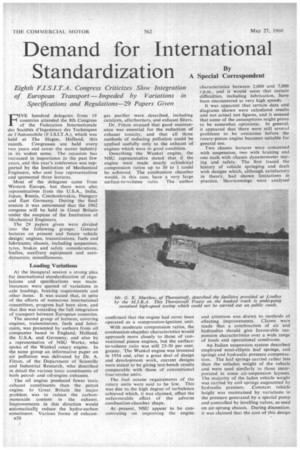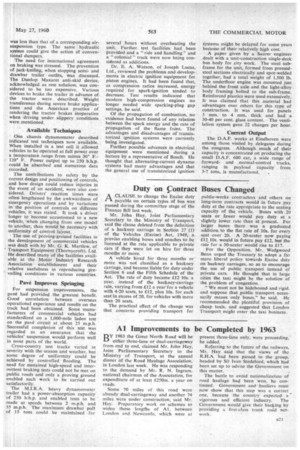Demand for International
Page 66

Page 67

If you've noticed an error in this article please click here to report it so we can fix it.
Standardization A Special C33Orrespondent FIVE hundred delegates from 19 countries attended the 8th Congress of the Federation Internationale des Societes d'Ingenieurs des Techniques de l'Automobile (F.I.S.I.T.A.), which was held at The Hague, Holland, this month. Congresses are held every two years and cover the motor industry in its widest sense. The occasion has increased in importance in the past few years, and this year's conference was supported by the Institution of Mechanical Engineers, who sent four representatives and sponsored three lectures.
Most of the delegates came from Western Europe, but there were also representatives from the U.S.A., India, Japan, Russia, Czechoslovakia, Hungary and East Germanys During the final session it was announced that the 1962 congress will be held in Great Britain under the auspices of the Institution of Mechanical Engineers.
The 29 papers given were divided into the following groups: General lectures on present and future vehicle design; engines, transmissions, fuels and lubricants; chassis, including suspension, tyres, brakes and • safety considerations; bodies, auxiliary equipment and aerodynamics; miscellaneous.
Loading Variations
At the inaugural session a strong plea • for international standardization of regulations and specifications was made. Instances were quoted of variations in axle loadings, braking requirements and other items. It was stated that, in spite of the efforts of numerous international committees, progress had been slow, and that this was retarding the full integration of transport between European countries, The second group of lectures, covering engines, transmissions, fuels and lubricants, was presented by authors from oil companies based in England, Holland, the U.S.A. and Germany, and also by a representative of NSU Werke, who spoke of the Wankel rotary engine. In the same group an informative paper on air pollution was delivered by Dr. A. Fitton, of the Department of Scientific and Industrial Research, who described in detail the various toxic constituents of both petroland oil-engine exhausts.
The oil engine produced fewer toxic exhaust constituents than the petrol engine. In Great Britain the major problem was to reduce the carbonmonoxide content in the exhaust. Improvements in this direction would automatically reduce the hydro-carbon constituent. Various forms of exhaust 1320 gas purifier were described, including catalysts, afterburners, and exhaust filters.
Dr. Fitton stressed that good maintenance was essential for the reduction of exhaust toxicity, and that all three methods of reducing pollution could be applied usefully only to the exhaust of engines which were in good condition.
Describing the Wankel engine, the NSU representative stated that if the engine were made nearly cylindrical compression ratios up to 30 to 1 could be achieved. The combustion chamber would, in this case, have a very large surface-to-volume ratio. The author confirmed that the engine had never been operated as a compression-ignition unit.
With moderate compression ratios, the combustion-chamber characteristics would approach more closely to those of conventional piston engines, hut the surfaceto-volume ratio was still 25-30 per cent. greater. The Wankel engine was invented in 1954 and, after a great deal of design and development work, current designs were stated to be giving test-bench results comparable with those of conventional four-stroke units.
The fuel octane requirements of the rotary units were said to be low. This was due to. the high degree of turbulence achieved which, it was claimed, offset the unfavourable effect of the adverse combustion-chamber shape.
At -present, NSU appear to be concentrating on improving the engine
characteristics between 2,000 and 7,000 r,p.m„ and it would seem that certain difficulties, including lubrication, have been encountered at very high speeds.
It was apparent that certain data and diagrams shown were calculated results and not actual test figures, and it seemed that some of the assumptions might prove to be somewhat optimistic. In general, it appeared that there were still several problems to _ be overcome before the rotary-piston engine becomes suitable for general use.
Two chassis lectures were concerned with suspension, two with braking and one each with .chassis dynamometer testing and safety. The first traced the history of vehicle springing and dealt with designs which, although satisfactory in theory, had shown limitations in practice. Shortcomings were analysed and attention was drawn to methods of effecting improvements. Claims were made that a combination of air and hydraulics should give favourable suspension characteristics over a wide range of loads and operational conditions.
An Italian suspension system described employed semi-elliptic leaf springs, coil springs and hydraulic pressure compensation. The leaf springscarried rather less than the unladen weight of the vehicle and were used similarly to those incorporated in some air-suspension layouts. The majority of the laden vehicle weight was carried by coil springs augmented by hydraulic pressure. Constant vehicle height was maintained by variations in the pressure generated by a special pump and controlled by levelling valves, as used on air-sprung chassis. During discussion, it was claimed that the cost of this design was less than that of a corresponding airsuspension type. The same hydraulic system could give the action of conventional dampers.
The need for international agreement on braking was stressed. The prevention of jack-knifing, when stopping semiand drawbar trailer outfits, was discussed. The Dunlop Maxaret anti-skid device, acknowledged as one solution, was considered to be too expensive. Various devices to brake the trailer in advance of the tractor were described. Weight transference during severe brake applications and the American practice of rendering the tractor brakes inoperative when driving under slippery conditions were mentioned,
Available Techniques
One chassis dynamometer described indicated test techniques now available. When installed in a test cell it allowed vehicles to be operated at full power over a temperature range from minus 30 F.120 F. Power output up to 250 b.h.p. could be absorbed and numerous data recorded.
The contributions to safety by the correct design and positioning of controls, and how design could reduce injuries in the event of an accident, were also considered. Drivers' reaction times were often lengthened by the awkwardness of emergency operations and by variations in the position of controls on different vehicles, it was stated. It took a driver longer to become accustomed to a new vehicle, when changing from one model to another, than Would be necessary with uniformity of control layout..
The use of proving-ground facilities in the development of commercial vehicles was dealt with by Mr. G. K. Martlew, of Transport Equipment (Thornycroft), Ltd. He described many of the facilities available at the Motor Industry Research Association establishment and their relative usefulness in reproducing prevailing conditions in various countries.
Pave Improves Springing.
For suspension improvements, the pave had provided the greatest benefit, Good correlation between overseas operational experience and results on the track had been obtained. Some manufacturers of commercial vehicles had standardized on a 1,000-mile laden test on the pave circuit at about 25 m.p.h. Successful completion of this test was regarded as an assurance that the vehicles' suspension would perform well in most parts of the world.
Cross-country test tracks varied in severity with the season and weather, but some degree of uniformity could be achieved by controlled flooding. The need for sustained high-speed and intermittent braking tests could not be met on public roads and only a proving ground enabled such work to be carried out satisfactorily.
The M.I.R.A. heavy dynamometer trailer had a power-absorption capacity of 250 b.h.p. and enabled tests to be made at speeds between 2 m.p.h. and 35 m.p.h. The maximum drawbar pull of 15 tons could be maintained for several hours without overheating the unit. Further. test facilities had been provided and a " ride and handling" and a " colonial " track were now being considered as additions.
Dr. E. A. Watson, of Joseph Lucas, Ltd., reviewed the problems and develop ments in electric ignition equipment for piston engines. It had been found that, as compression ratios increased, energy required for spark-ignition tended to decrease. Test results indicated that modern high-compression engines no longer needed wide sparking-plug gap settings, he said.
Of the propagation of combustion, no evidence had been found of any relation between the spark energy and the rate of propagation of the flame front. The advantages and disadvantages of transistorized ignition systems were currently being investigated. Further possible advances in electrical equipment were mentioned during a lecture by a representative of Bosch. He thought that alternating-current dynamo systems had many advantages and that the general use of transistorized ignition systems might be delayed for some years because of their relatively high cost.
A paper given by a Saurer engineer dealt with a unit-construction single-deck bus body for city work, The steel subframe for the unit, formed from pressedsteel sections electrically and spot-welded together, had a total weight of 1,500 lb. The underfloor engine was mounted just behind the front axle and the light-alloy body framing bolted to the sub-frame. Reinforced plastics were used extensively, It was claimed that this material had advantages over others for this type of construction. It was used for panels 3 mm. to 4 mm. thick and had a 30-40 per cent. glass content. The ventilation system gave 22 changes per hour.
Current Output
The D.A.F. works at Eindhoven were among those visited by delegates during the congress. Although much of their capacity is concentrated on producing the small D.A.F. 600 car, a wide range of forwardand normal-control trucks, ranging in payload capacity from 3-7 tons, is manufactured.
















































































































